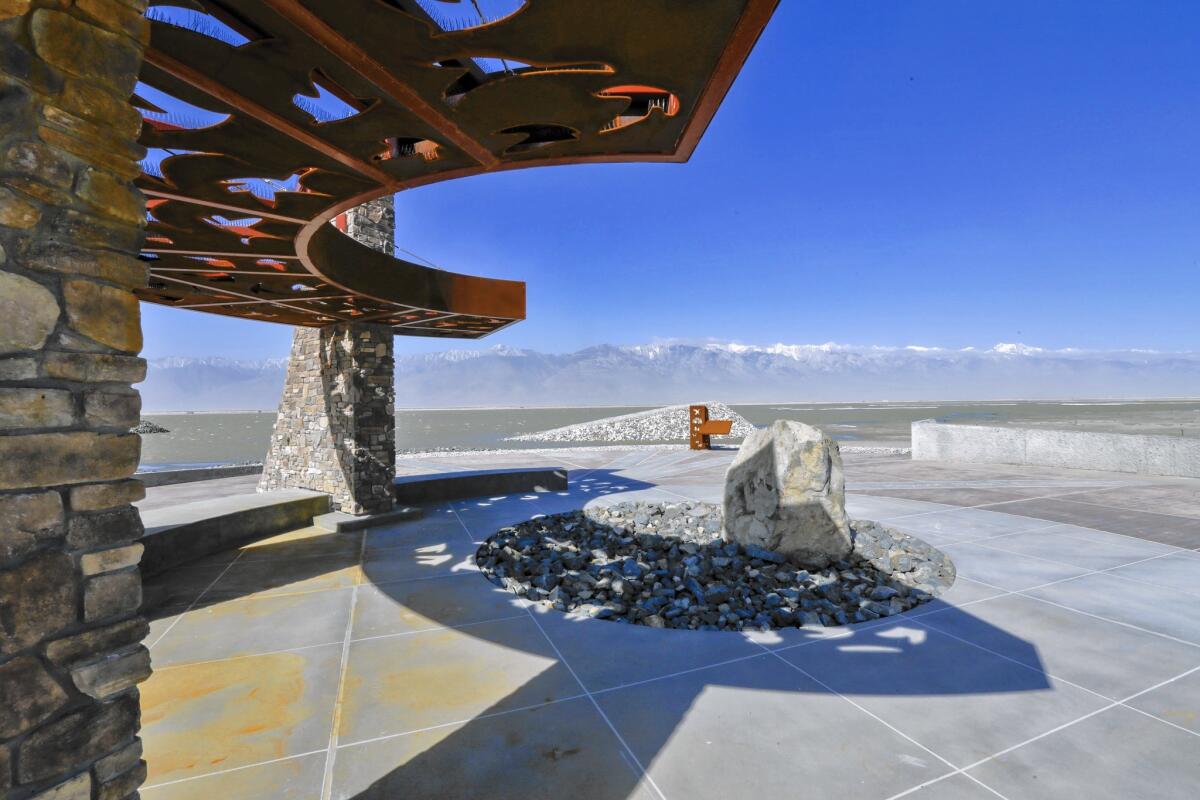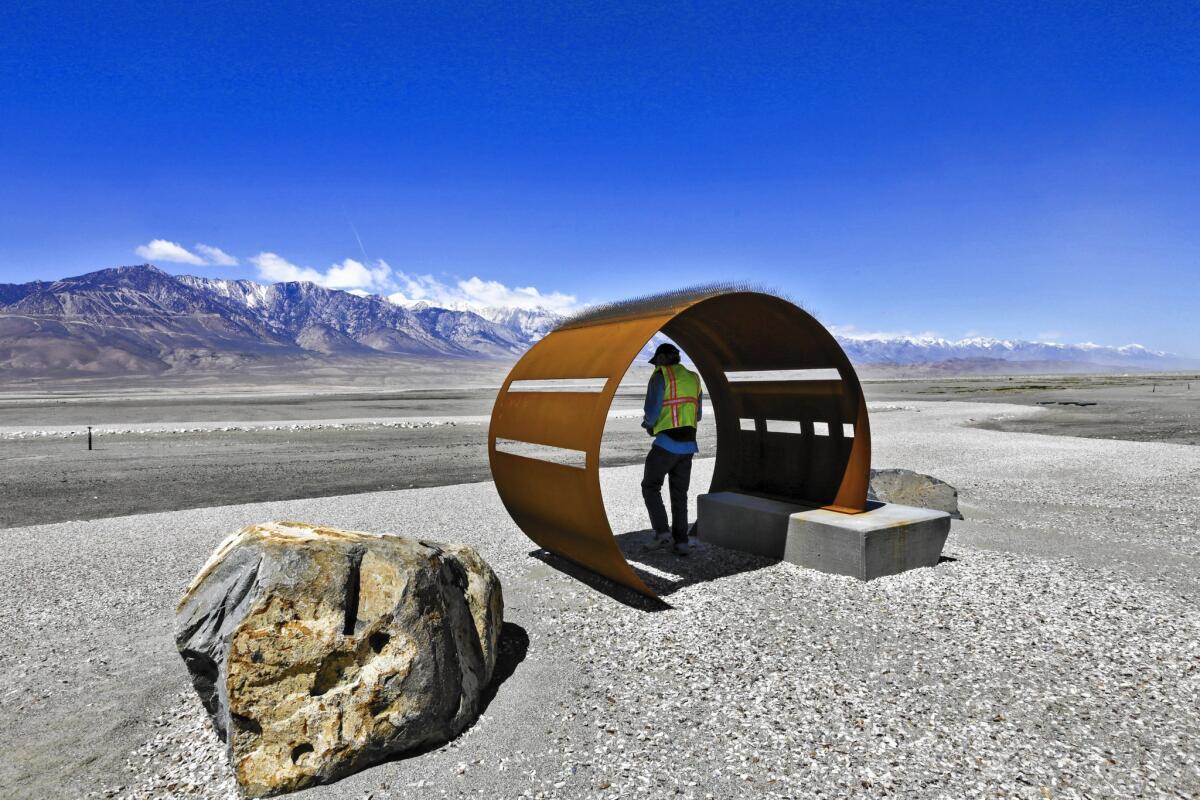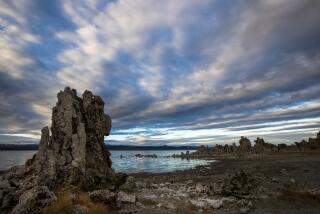Is it an olive branch or ‘crazy’? Owens Valley is skeptical of Angelenos bearing gifts

Reporting From Lone Pine, Calif. — Los Angeles insists that it had the best of intentions as it erected the monument of granite and sculpted earth that is now rising from a dry bed of Owens Lake 200 miles to the north.
Department of Water and Power officials saw it as a gesture of reconciliation for taking the region’s water more than a century ago. The interactive artwork, to be unveiled this week, features a public plaza with curved granite walls inspired by the wing shapes of shorebirds. Sculptures of earth and rock have been made to resemble whitecaps. Scenic gravel trails wind throughout.
It was all intended as a $4.6-million olive branch from Los Angeles to the people of Owens Valley, where animosities have simmered since the city’s aqueduct, completed in 1913, drained Owens Lake, turning it into a noxious dust bowl.

But here in the heart of the valley, Angelenos bearing gifts have always elicited skepticism.
Even before its grand opening Friday, critics are taking potshots at the Los Angeles Department of Water and Power’s Owens Lake Trails project, which the city sees as a destination for hikers and bird watchers and a place for community gatherings and wedding ceremonies.
Locals wonder about its appeal in such a remote landscape that can grow hellish in summer, where winds often whip up eye-stinging sand and salt crystals.
“Wedding ceremonies on Owens Lake? Good luck finding a restroom,” mused a Lone Pine business leader, who asked that her name not be used for fear of retribution from her landlord, the DWP.
Mary Roper, president of the Owens Valley Committee, a nonprofit environmental group, shrugged off the cost as “a small price to pay after giving Los Angeles cheap water for almost 100 years.”
Then there was Jenifer Castaneda, owner of Blue Sky Real Estate in Lone Pine, who echoed the sentiments of many.
“It’s crazy,” she said. “They could have put that money to better use by releasing some of the developable land they own on Main Street.”
Not everyone feels that way.
Admirers include Ted Schade, a former air pollution control officer who monitored the city’s efforts to control choking dust storms on the 110-square-mile lake bed between the 14,000-foot Sierra Nevada on the west and 11,000-foot Inyo Mountains on the east.
“It’s California’s version of Stonehenge,” Schade said. “It’s cool, built to last and off the beaten path.”
And that could be a problem. The site is not designed to accommodate large crowds.
“This isn’t something we just plopped down on dry Owens Lake,” Terry Schneider, a spokeswoman for the DWP who grew up in Owens Valley, said in response to the jibes from locals.
“It was required by the State Lands Commission, and we made it a place that would boost the local economy and people would find beautiful and informing, a place visitors would return to with family members and friends.”
The controversy is disappointing to the architect who designed the monument, Perry Cardoza, vice president of NUVIS Landscape Architecture & Planning in Costa Mesa.
Cardoza said he felt “like a proud father” after the project was approved.
Spanning 700 acres, it fulfills a State Lands Commission requirement that the city increase visitor access and enhance wildlife habitat. The requirement is included in a continuing $305-million dust-mitigation effort focused on an area about a mile west of California 136, 13 miles southeast of Lone Pine and 200 miles north of Los Angeles.
“The materials we used in its construction — concrete, granite, steel and rebar coated to resist corrosion — were selected to harmonize with the landscape and withstand extremely hostile soil conditions,” Cardoza said. “Interpretive signs at overlooks and along the trails tell the story of this historic site and its wildlife. Massive boulders serve as rest stops, providing shade and safety.
“We are trying to promote this project as a positive piece of land art that the people of Owens Valley can be proud of,” he said. “It’s almost like an olive branch, and if it heals some of their bad feelings, well, that would be wonderful.”
Some would call that an understatement.
As Los Angeles boomed in the early 1900s, the city sent agents posing as farmers and ranchers to buy water and land rights in the eastern Sierra watershed. With those rights in hand, the city built a 233-mile-long aqueduct and began diverting water that had historically flowed into the lake.
The water transfers triggered one of the city’s longest and most bitter legal tangles.
DWP ratepayers have already spent more than $1.3 billion to control the dust with vegetation, gravel, tilling and shallow flooding. The measures have largely succeeded, reducing dust pollution off the lake bed by about 95%.
One of the unintended successes: Flooding portions of the lake to control dust pollution attracts tens of thousands of migrating waterfowl and shorebirds in fall and spring.
On April 21, more than 100 people with binoculars around their necks flocked here to participate in the second annual Owens Lake Bird Festival, a celebration of the fresh beginnings on a lake bed that had existed for decades as an all-but-lifeless moonscape.
This year’s event included bird-watching expeditions led by local environmentalists and DWP biologists along four miles of gravel trails linking the new public plaza on the lake to wildlife-viewing areas surrounded by meadows and shallow salt lakes colored by algae and minerals and teeming with migrating birds.
In preparation for the festivities, Michael Prather, a Lone Pine botanist and co-founder of the bird festival, toured the site.
“Things are looking good out there,” Prather said, peering through binoculars at thousands of American avocets, black-necked stilts and western sandpipers preening together in sheets of water siphoned off the Los Angeles Aqueduct to control dust.
“This is my idea of a world-class addition to life in Owens Valley,” he added with a smile. “And we didn’t even have to go to court to get it.”
ALSO
Former Berkeley law school dean blasts new sexual misconduct review against him
Hail, rainbows, snow, downed trees and signs: A blustery Monday in Southern California
More to Read
Sign up for Essential California
The most important California stories and recommendations in your inbox every morning.
You may occasionally receive promotional content from the Los Angeles Times.











